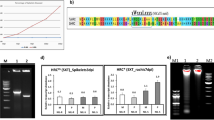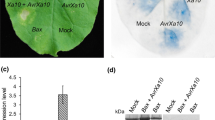Abstract
Anti-apoptotic gene Ced-9 enhanced resistance against Fusarium oxysporum f. sp. cubense (Foc) in the susceptible banana cultivar Rasthali by arresting tissue necrosis. The embryogenic cell suspension of banana cultivar Rasthali was stably transformed with Ced-9 gene and transformed lines were regenerated independently. The putative transgenic lines were analyzed with PCR using gene primers and further subjected to Southern blot to estimate copy number. The root-challenge bioassay with Foc showed 17–51% Vascular Discoloration Index in independent transformants compared to untransformed banana cv Rasthali (98% VDI). Four transgenic events showed a higher level of resistance over a period of 6 months. Overcoming tissue necrosis is the most ideal method to avoid Fusarium multiplication and spread in banana. Oxidative stress-induced cell necrosis is prevented by the activation of antiapoptotic pathways by Ced-9 and is proving to be an effective method to control this dreaded disease. This is the first report from India on the generation of transgenic banana cultivar Rasthali expressing antiapoptotic Ced-9 gene for resistance to Fusarium wilt.








Similar content being viewed by others
References
Arinaitwe G, Remy S, Strosse H, Swennen R, Sági L (2004) Agrobacterium-and particle bombardment-mediated transformation of a wide range of banana cultivars. In: Mohan Jain S, Swennen R (eds) Banana improvement: cellular, molecular biology, and induced mutations. Science Publishers Inc, Enfield, pp 351–357
Chakrabarti A, Ganapathi TR, Mukherjee PK, Bapat VA (2003) MSI-99, a magainin analogue, imparts enhanced disease resistance in transgenic tobacco and banana. Planta 216:587–596
Chen S, Dickman MB (2004) Bcl-2 family members localize to tobacco chloroplasts and inhibit programmed cell death induced by chloroplast targeted herbicides. J Exp Bot 55:2617–2623
Dale JL, James A, Paul JY, Khanna H, Smith M, Echeverria SP, Bastidas FG, Kema G, Waterhouse P, Mengersen K, Harding R (2017) Transgenic Cavendish bananas with resistance to Fusarium wilt tropical race 4. Nat Commun 8:1496. https://doi.org/10.1038/s41467-017-01670-6
Dickman MB, de Figueiredo P (2013) Death be not proud-cell death control in plant fungal interactions. PLoS Pathog 9(9):e1003542. https://doi.org/10.1371/journal.ppat.1003542
Dickman MB, Park YK, Oltersdorf T, Li W, Clemente T, French R (2001) Abrogation of disease development in plants expressing animal antiapoptotic genes. PNAS 98:6957–6962
Ghag SB, Shekhawat UKS, Ganapathi TR (2012) Petunia floral defensins with unique prodomains as novel candidates for development of Fusarium wilt resistance in transgenic banana plants. PLoS ONE. https://doi.org/10.1371/journal.pone.0039557,e39557
Ghag SB, Shekhawat UK, Ganapathi TR (2014) Native cell-death genes as candidates for developing wilt resistance in transgenic banana plants. AoB Plants. https://doi.org/10.1093/aobpla/plu037
Khanna H, Becker D, Kleidon J, Dale JL (2004) Centrifugation assisted Agrobacterium-tumefaciens mediated transformation (CAAT) of embryogenic cell suspensions of banana (Musa spp. Cavendish AAA and Lady finger AAB). Mol Breed 14:239–252
Khanna HK, Paul JY, Harding RM, Dickman MB, Dale JL (2007) Inhibition of Agrobacterium-induced cell death by antiapoptotic gene expression leads to very high transformation efficiency of banana. MPMI 20:1048–1054. https://doi.org/10.1094/MPMI-20-9-1048
Lam E, Kato N, Lawton M (2001) Programmed cell death, mitochondria and the plant hypersensitive response. Nature 411:848–853
Li W, Dickman MB (2004) Abiotic stress induces apoptotic-like features in tobacco that is inhibited by expression of human Bcl-2. Biotechnol Lett 26:8
Lincoln JE, Richael C, Overduin B, Smith K, Bostock R, Gilchrist DG (2002) Expression of the anti-apoptotic baculovirus p35 gene in tomato blocks programmed cell death and provides broad-spectrum resistance to disease. Proc Natl Acad Sci USA 99:15217–15221
Lutz RJ (2000) Role of the BH3 (Bcl-2 homology 3) domain in the regulation of apoptosis and Bcl-2-related proteins. Biochem Soc Trans 28:2
Magambo B, Khanna H, Arinaitwe G, Tendo S, Arinaitwe IK, Kubiriba J, Tushemereirwe W, Dale JL (2016) Inhibition of cell death as an approach for development of transgenic resistance against Fusarium wilt disease. Afr J Biotechnol 15:786–797
Marenkova TV, Loginova DB, Deineko EV (2012) Mosaic patterns of transgene expression in plants. Russ J Genet 48:293–306
Mitsuhara MKA, Miura M, Ohashi Y (1999) Animal cell-death suppressors Bcl-xL and Ced-9 inhibit cell death in tobacco plants. Curr Biol 9:775–778
Mittler R, Blumwald E (2010) Genetic engineering for modern agriculture: challenges and perspectives. Annu Rev Plant Biol 61:443–462. https://doi.org/10.1146/annurevarplant-042809-112116
Mohandas S, Sowmya HD, Saxena AK, Meenakshia S, Rania RT, Mahmood R (2013) Transgenic banana cv. Rasthali (AAB, Silk gp) harboring Ace-AMP1 gene imparts enhanced resistance to Fusarium oxysporum f. sp. cubense race 1. Sci Hortic 164:392–399
Moore NY, Pegg KG, Buddenhagen IW, Bentley S (2001) Fusarium wilt of banana: a diverse clonal pathogen of a domesticated clonal host. In: Summerell BA, leslie JF, Backhouse D, Bryden WL, Burgess LW (eds) Fusarium, pp 212–224
Paul JY, Becker DK, Dickman MB, Harding RM, Khanna HK, Dale JL (2011) Apoptosis-related genes confer resistance to Fusarium wilt in transgenic ‘Lady Finger’ bananas. Plant Biotechnol J 9:1141–1149
Pennell R, Lamb C (1997) Programmed cell death in plants. Plant Cell 9:1157–1168
Ploetz RC (2015) Management of Fusarium wilt of banana: a review with special reference to tropical race 4. Crop Protect 73:7–15. https://doi.org/10.1016/j.cropro.2015.01.007
Ploetz RC, Pegg KG (1997) Fusarium wilt of banana and Wallace's line: was the disease originally restricted to his Indo-Malayan region? Australas Plant Path 26:239–249
Qiao J, Mitsuhara I, Yazaki Y, Sakano K, Gotoh Y, Miura M, Ohashi Y (2002) Enhanced resistance to salt, cold and wound stresses by overproduction of animal cell death suppressors Bcl-xL and Ced-9 in tobacco cells—their possible contribution through improved function of organella. Plant Cell Physiol 43(9):992–1005
Reape TJ, Molony EM, McCabe PF (2008) Programmed cell death in plants: distinguishing between different modes. J Exp Bot 59:435–444. https://doi.org/10.1093/jxb/erm258
Sambrook J, Fritsch EF, Maniatis S (1989) Molecular sloning: a laboratory manual, 2nd edn. Cold Spring Harbor CSHL Press, Cold Spring Harbor
Sika KC, Kefela T, Adoukonou-Sagbadja H, Ahoton L, Saidou A, Baba-Moussa L, Baptiste LJ, Kotconi SO, Gachomo EW (2015) A simple and efficient genomic DNA extraction protocol for large scale genetic analyses of plant biological systems. Plant Gene 1:43–45
Smith LJ, Smith MK, Tree D, O’Keefe D, Galea VJ (2008) Development of a small-plant bioassay to assess banana grown from tissue culture for consistent infection by Fusarium oxysporum f. sp. cubense. Australas Plant Pathol 2:171–179
Strosse H, Schoofs H, Panis B, Andre E, Reyniers K, Swennen R (2006) Development of embryogenic cell suspension from shoot meristematic tissue in bananas and plantains (Musa spp.). Plant Sci 170:104–112
Sunisha C, Sowmya HD, Usharani TR, Umesha M, Gopalkrishna HR, Saxena A (2019) Deployment of stacked antimicrobial genes in banana for stable tolerance against Fusarium oxysporum f.sp. cubense through genetic transformation. Mol Biotechnol. https://doi.org/10.1007/s12033-019-00219-w
Thaler JS, Owen B, Higgins VJ (2004) The role of the jasmonate response in plant susceptibility to diverse pathogens with a range of lifestyles. Plant Physiol 135:530–538
Uren AG, O’Rourke K, Aravind L, Pisabarro T, Seshagiri S, Koonin EV, Dixit VM (2000) Identification of paracaspases and metacaspases. Two ancient families of caspase like proteins, one of which plays a key role in MALT lymphoma. Mol Cell 6:961–967
Xu P, Rogers SJ, Roossinck M (2004) Expression of antiapoptotic genes Bcl-xL and Ced-9 in tomato enhances tolerance to viral-induced necrosis and abiotic stress. Proc Natl Acad Sci 101(44):15805–15810. https://doi.org/10.1073/pnas.0407094101
Acknowledgements
The authors are thankful to DBT-BIRAC for funding under the project Development and Transfer of Technology from Queensland University of Technology (QUT), Australia to India for Biofortification and Disease Resistance in Banana. This is the part of Ph.D. dissertation work of first author.
Funding
This study was funded by the Department of Biotechnology—Biotechnology Industry Research Association Council.
Author information
Authors and Affiliations
Contributions
Conceived and designed the experiments: TRU, HDS and CS. Performed the experiments: CS and HDS Analyzed the data: CS, TRU, HDS, MU and SS. Paper: CS, TRU, HDS and HRG
Corresponding author
Ethics declarations
Conflict of interest
Authors Mrs. Sunisha. C, Dr. Sowmya H.D, Dr. Usharani T.R, Mr. Umesha M, Dr.Sriram.S and Gopalkrishna H.R have received research grants from the Department of Biotechnology—Biotechnology Industry Research Association Council.
Ethical approval
This article does not contain any studies with human participants or animals performed by any of the authors.
Rights and permissions
About this article
Cite this article
Sunisha, C., Sowmya, H.D., Usharani, T.R. et al. Induction of Ced9 mediated anti-apoptosis in commercial banana cultivar Rasthali for stable resistance against Fusarium wilt. 3 Biotech 10, 371 (2020). https://doi.org/10.1007/s13205-020-02357-4
Received:
Accepted:
Published:
DOI: https://doi.org/10.1007/s13205-020-02357-4




